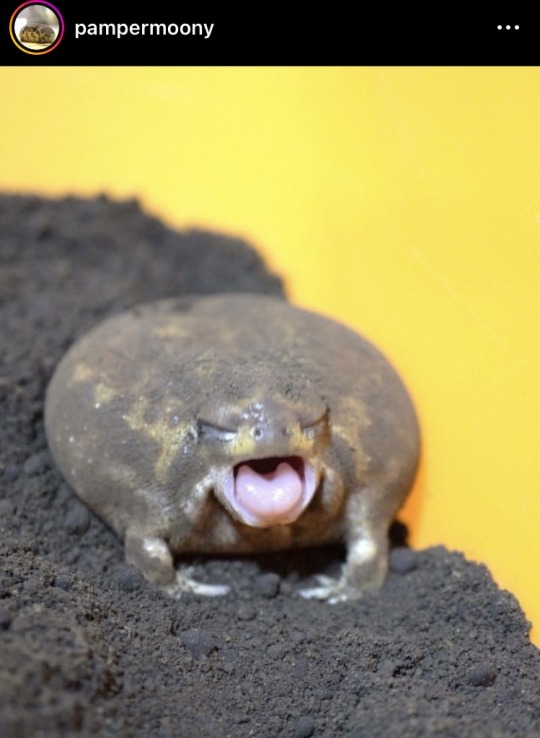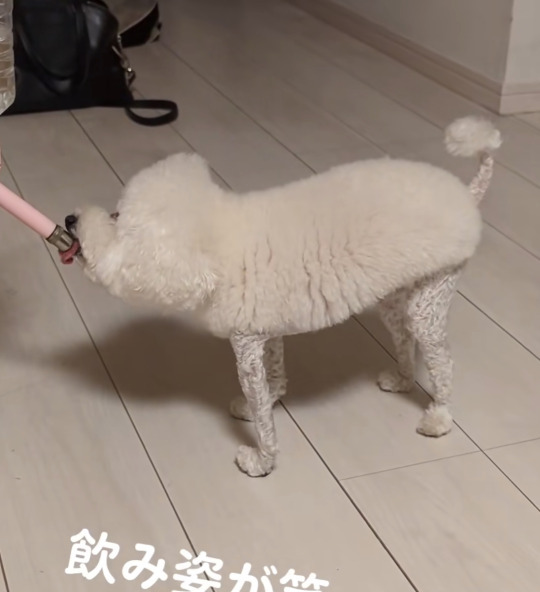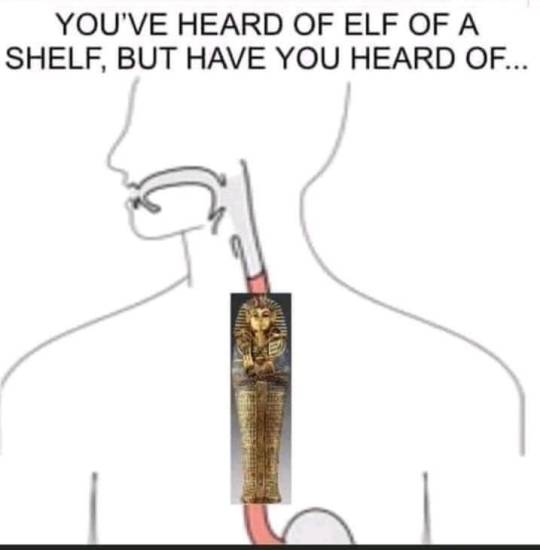Text
If you ever tagged me to do one of those tag game thingies and I never did it:
1) Thank you, seriously. Those are fun and being included shows that my followers care enough to want to learn more about me.
2) Very sorry about that, it’s extremely likely that I said to myself “Cool! But I’m busy at the moment, I’ll have to do this later today or tomorrow” before proceeding to just straight-up forget, now it’s too far back in my notifications and/or your blog to find again.
185K notes
·
View notes
Text

[I.D. an edited pyramid graph of maslow's hierarchy of needs where large text covering every section of basic, psychological and self-fulfillment needs read "people online telling me they like the thing i made". end I.D.] (imagine description by @lemondoddle )
77K notes
·
View notes
Text
An obscenely tall dwarf has daddy issues, hunts him across an entire continent
Explain your work in progress badly:
“Only this ragtag band of plucky teenagers have got the gumption to stop the second coming of Christ”
10K notes
·
View notes
Text
Words for Skin Tone | How to Describe Skin Color
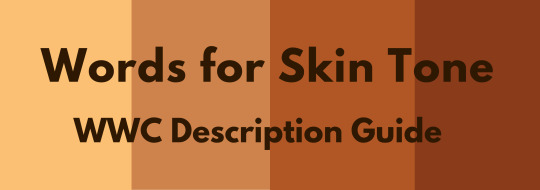
We discussed the issues describing People of Color by means of food in Part I of this guide, which brought rise to even more questions, mostly along the lines of “So, if food’s not an option, what can I use?” Well, I was just getting to that!
This final portion focuses on describing skin tone, with photo and passage examples provided throughout. I hope to cover everything from the use of straight-forward description to the more creatively-inclined, keeping in mind the questions we’ve received on this topic.
Standard Description
Basic Colors

Pictured above: Black, Brown, Beige, White, Pink.
“She had brown skin.”
This is a perfectly fine description that, while not providing the most detail, works well and will never become cliché.
Describing characters’ skin as simply brown or beige works on its own, though it’s not particularly telling just from the range in brown alone.
Complex Colors
These are more rarely used words that actually “mean” their color. Some of these have multiple meanings, so you’ll want to look into those to determine what other associations a word might have.

Pictured above: Umber, Sepia, Ochre, Russet, Terra-cotta, Gold, Tawny, Taupe, Khaki, Fawn.
Complex colors work well alone, though often pair well with a basic color in regards to narrowing down shade/tone.
For example: Golden brown, russet brown, tawny beige…
As some of these are on the “rare” side, sliding in a definition of the word within the sentence itself may help readers who are unfamiliar with the term visualize the color without seeking a dictionary.
“He was tall and slim, his skin a russet, reddish-brown.”
Comparisons to familiar colors or visuals are also helpful:
“His skin was an ochre color, much like the mellow-brown light that bathed the forest.”
Modifiers
Modifiers, often adjectives, make partial changes to a word.The following words are descriptors in reference to skin tone.
Dark - Deep - Rich - Cool
Warm - Medium - Tan
Fair - Light - Pale
Rich Black, Dark brown, Warm beige, Pale pink…
If you’re looking to get more specific than “brown,” modifiers narrow down shade further.
Keep in mind that these modifiers are not exactly colors.
As an already brown-skinned person, I get tan from a lot of sun and resultingly become a darker, deeper brown. I turn a pale, more yellow-brown in the winter.
While best used in combination with a color, I suppose words like “tan” “fair” and “light” do work alone; just note that tan is less likely to be taken for “naturally tan” and much more likely a tanned White person.
Calling someone “dark” as description on its own is offensive to some and also ambiguous. (See: Describing Skin as Dark)
Undertones
Undertones are the colors beneath the skin, seeing as skin isn’t just one even color but has more subdued tones within the dominating palette.
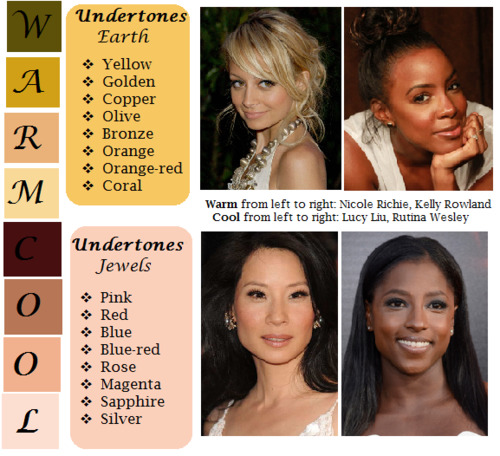
pictured above: warm / earth undertones: yellow, golden, copper, olive, bronze, orange, orange-red, coral | cool / jewel undertones: pink, red, blue, blue-red, rose, magenta, sapphire, silver.
Mentioning the undertones within a character’s skin is an even more precise way to denote skin tone.
As shown, there’s a difference between say, brown skin with warm orange-red undertones (Kelly Rowland) and brown skin with cool, jewel undertones (Rutina Wesley).
“A dazzling smile revealed the bronze glow at her cheeks.”
“He always looked as if he’d ran a mile, a constant tinge of pink under his tawny skin.”
Standard Description Passage
“Farah’s skin, always fawn, had burned and freckled under the summer’s sun. Even at the cusp of autumn, an uneven tan clung to her skin like burrs. So unlike the smooth, red-brown ochre of her mother, which the sun had richened to a blessing.”
-From my story “Where Summer Ends” featured in Strange Little Girls
Here the state of skin also gives insight on character.
Note my use of “fawn” in regards to multiple meaning and association. While fawn is a color, it’s also a small, timid deer, which describes this very traumatized character of mine perfectly.
Though I use standard descriptions of skin tone more in my writing, at the same time I’m no stranger to creative descriptions, and do enjoy the occasional artsy detail of a character.
Creative Description
Whether compared to night-cast rivers or day’s first light…I actually enjoy seeing Characters of Colors dressed in artful detail.
I’ve read loads of descriptions in my day of white characters and their “smooth rose-tinged ivory skin”, while the PoC, if there, are reduced to something from a candy bowl or a Starbucks drink, so to actually read of PoC described in lavish detail can be somewhat of a treat.
Still, be mindful when you get creative with your character descriptions. Too many frills can become purple-prose-like, so do what feels right for your writing when and where.
Not every character or scene warrants a creative description, either. Especially if they’re not even a secondary character.
Using a combination of color descriptions from standard to creative is probably a better method than straight creative. But again, do what’s good for your tale.
Natural Settings - Sky
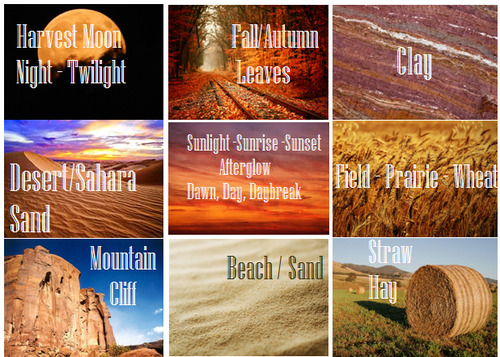
Pictured above: Harvest Moon -Twilight, Fall/Autumn Leaves, Clay, Desert/Sahara, Sunlight - Sunrise - Sunset - Afterglow - Dawn- Day- Daybreak, Field - Prairie - Wheat, Mountain/Cliff, Beach/Sand/Straw/Hay.
Now before you run off to compare your heroine’s skin to the harvest moon or a cliff side, think about the associations to your words.
When I think cliff, I think of jagged, perilous, rough. I hear sand and picture grainy, yet smooth. Calm. mellow.
So consider your character and what you see fit to compare them to.
Also consider whose perspective you’re describing them from. Someone describing a person they revere or admire may have a more pleasant, loftier description than someone who can’t stand the person.
“Her face was like the fire-gold glow of dawn, lifting my gaze, drawing me in.”
“She had a sandy complexion, smooth and tawny.”
Even creative descriptions tend to draw help from your standard words.
Flowers
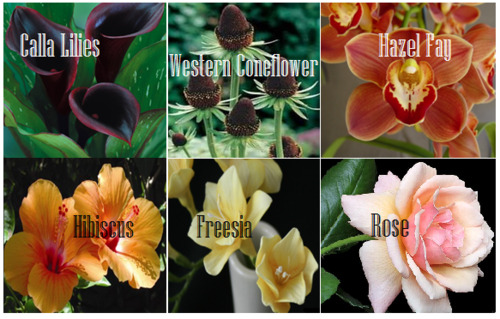
Pictured above: Calla lilies, Western Coneflower, Hazel Fay, Hibiscus, Freesia, Rose
It was a bit difficult to find flowers to my liking that didn’t have a 20 character name or wasn’t called something like “chocolate silk” so these are the finalists.
You’ll definitely want to avoid purple-prose here.
Also be aware of flowers that most might’ve never heard of. Roses are easy, as most know the look and coloring(s) of this plant. But Western coneflowers? Calla lilies? Maybe not so much.
“He entered the cottage in a huff, cheeks a blushing brown like the flowers Nana planted right under my window. Hazel Fay she called them, was it?”
Assorted Plants & Nature

Pictured above: Cattails, Seashell, Driftwood, Pinecone, Acorn, Amber
These ones are kinda odd. Perhaps because I’ve never seen these in comparison to skin tone, With the exception of amber.
At least they’re common enough that most may have an idea what you’re talking about at the mention of “pinecone.“
I suggest reading out your sentences aloud to get a better feel of how it’ll sounds.
“Auburn hair swept past pointed ears, set around a face like an acorn both in shape and shade.”
I pictured some tree-dwelling being or person from a fantasy world in this example, which makes the comparison more appropriate.
I don’t suggest using a comparison just “cuz you can” but actually being thoughtful about what you’re comparing your character to and how it applies to your character and/or setting.
Wood

Pictured above: Mahogany, Walnut, Chestnut, Golden Oak, Ash
Wood can be an iffy description for skin tone. Not only due to several of them having “foody” terminology within their names, but again, associations.
Some people would prefer not to compare/be compared to wood at all, so get opinions, try it aloud, and make sure it’s appropriate to the character if you do use it.
“The old warlock’s skin was a deep shade of mahogany, his stare serious and firm as it held mine.”
Metals

Pictured above: Platinum, Copper, Brass, Gold, Bronze
Copper skin, brass-colored skin, golden skin…
I’ve even heard variations of these used before by comparison to an object of the same properties/coloring, such as penny for copper.
These also work well with modifiers.
“The dress of fine white silks popped against the deep bronze of her skin.”
Gemstones - Minerals
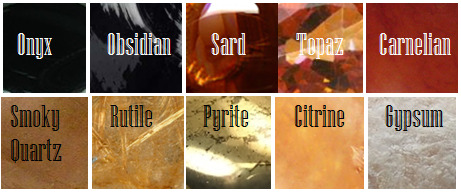
Pictured above: Onyx, Obsidian, Sard, Topaz, Carnelian, Smoky Quartz, Rutile, Pyrite, Citrine, Gypsum
These are trickier to use. As with some complex colors, the writer will have to get us to understand what most of these look like.
If you use these, or any more rare description, consider if it actually “fits” the book or scene.
Even if you’re able to get us to picture what “rutile” looks like, why are you using this description as opposed to something else? Have that answer for yourself.
“His skin reminded her of the topaz ring her father wore at his finger, a gleaming stone of brown, mellow facades.”
Physical Description
Physical character description can be more than skin tone.
Show us hair, eyes, noses, mouth, hands…body posture, body shape, skin texture… though not necessarily all of those nor at once.
Describing features also helps indicate race, especially if your character has some traits common within the race they are, such as afro hair to a Black character.
How comprehensive you decide to get is up to you. I wouldn’t overdo it and get specific to every mole and birthmark. Noting defining characteristics is good, though, like slightly spaced front teeth, curls that stay flopping in their face, hands freckled with sunspots…
General Tips
Indicate Race Early: I suggest indicators of race be made at the earliest convenience within the writing, with more hints threaded throughout here and there.
Get Creative On Your Own: Obviously, I couldn’t cover every proper color or comparison in which has been “approved” to use for your characters’ skin color, so it’s up to you to use discretion when seeking other ways and shades to describe skin tone.
Skin Color May Not Be Enough: Describing skin tone isn’t always enough to indicate someone’s ethnicity. As timeless cases with readers equating brown to “dark white” or something, more indicators of race may be needed.
Describe White characters and PoC Alike: You should describe the race and/or skin tone of your white characters just as you do your Characters of Color. If you don’t, you risk implying that White is the default human being and PoC are the “Other”).
PSA: Don’t use “Colored.” Based on some asks we’ve received using this word, I’d like to say that unless you or your character is a racist grandmama from the 1960s, do not call People of Color “colored” please.
Not Sure Where to Start? You really can’t go wrong using basic colors for your skin descriptions. It’s actually what many people prefer and works best for most writing. Personally, I tend to describe my characters using a combo of basic colors + modifiers, with mentions of undertones at times. I do like to veer into more creative descriptions on occasion.
Want some alternatives to “skin” or “skin color”? Try: Appearance, blend, blush, cast, coloring, complexion, flush, glow, hue, overtone, palette, pigmentation, rinse, shade, sheen, spectrum, tinge, tint, tone, undertone, value, wash.
Skin Tone Resources
List of Color Names
The Color Thesaurus
Skin Undertone & Color Matching
Tips and Words on Describing Skin
Photos: Undertones Described (Modifiers included)
Online Thesaurus (try colors, such as “red” & “brown”)
Don’t Call me Pastries: Creative Skin Tones w/ pics I
Writing & Description Guides
WWC Featured Description Posts
WWC Guide: Words to Describe Hair
Writing with Color: Description & Skin Color Tags
7 Offensive Mistakes Well-intentioned Writers Make
I tried to be as comprehensive as possible with this guide, but if you have a question regarding describing skin color that hasn’t been answered within part I or II of this guide, or have more questions after reading this post, feel free to ask!
~ Mod Colette
167K notes
·
View notes
Text
What I love about writing is when I'm forcing myself to write the middle parts to get to the bits I wanna write, & I end up writing a really cool scene ?? In the middle parts I wasn't even excited to write ?? That makes the process fun again & makes me remember why I love writing
4K notes
·
View notes
Text
Being a writer is so weird. You just go "hey I'm gonna invent a guy to emotionally devastate you with, who's in?" and people from all over the world are like "fuck yeah I'm in"
6K notes
·
View notes
Text
my 60yo technologically challenged dad is obsessed with silverback gorillas for some reason and today he asked what a furry was. when i explained it and explained fursonas he said without missing a beat “i’d be a gorilla” and im still shaking over this….. this man announced his own fursona within one (1) minute i.e. 60 seconds of learning what a furry is
96K notes
·
View notes
Text
Guide: Natural Character Arcs
Anonymous asked: My MC will have a "not my circus, not my monkeys"- behavior, but I want her to slowly want to help peopel as she gets more powerful throughout the series and eventually grows into her role as protector of the people. I want to give her natural character growth without it seeming "out of nowhere" or "out of character" since it will be a total 180 from the start of everything. Do you have any tips for the natural transition in character development that is drastically different from the start?
(Ask edited for length...)
Having a character do a complete but natural 180 between the beginning and end of the story is what's called a "character arc."
Here are the steps in creating a natural character arc:
1 - Understand the Internal Conflict - Stories are either plot-driven (centered on an external conflict/problem in the character's world), character-driven (centered on an internal conflict/problem in the character's self), or a combination of both. Character arc occurs in stories that are character-driven or both plot and character-driven, mainly in the protagonist and other important main characters. It's this problem in the character's self that causes who they are in the beginning of the story, and it's this problem that they must resolve in order to change by the end.
2 - Choose a Relevant Internal Conflict - Your protagonist needs to have an internal conflict that is relevant to the story events. If your story is entirely character-driven, the character arc is the whole story. The events of the story should naturally stem from your character's journey to resolve their internal conflict. If your story is partially plot-driven, the internal conflict should tie into the external conflict in some way. Both conflicts should stem from the same problem, or the path that leads to resolving the external conflict should lead to resolving the internal conflict--either directly or indirectly.
3 - Events = Experiences = Change - As the events of your story unfold, your character should have experiences as a result of those events that impact their understanding of their internal conflict. Let's say your character's internal conflict is the belief that they have no value beyond their role in a villainous organization. As the events of the story unfold, they would need to start seeing evidence that challenges that belief, makes them ask questions, and motivates them to push against the boundaries of that belief. In other words, as this character gets involved with things outside the organization, they start to see evidence that they do have value outside their role in the organization. This avalanches into questioning not just their belief but the organization itself and their involvement of it. As they test the waters of this new understanding and find confirmation that change is right for them, the change naturally takes place.
4 - Include Doubts, Fails, and Setbacks - Although you want the overall trajectory of their arc to be in the direction of their change, you still want to illustrate their doubts (Could this really be true? Do I really have value beyond the organization? Could the organization be bad? No, surely that can't be right...) and have the occasional failure or setback in their attempt to change. In other words, you don't want them to have an easy transition from where they are at the beginning to where they are at the end. Their internal conflict's claws are in pretty deep, so there needs to be some struggle as they try to move in a different direction.
5 - Show the Completed Change in Action - Wherever they end up, you want to give the character the opportunity to show that they've changed. For example, maybe the villainous organization comes at them with an "offer they can't refuse," and the old them would have jumped at that opportunity, but they're not that person anymore. Showing them refusing this offer illustrates that they've really and truly changed once and for all.
Happy writing!
•••••••••••••••••••••••••••••••••
I’ve been writing seriously for over 30 years and love to share what I’ve learned. Have a writing question? My inbox is always open!
Learn more about WQA
Visit my Master List of Top Posts
Go to ko-fi.com/wqa to buy me coffee or see my commissions
279 notes
·
View notes
Text
at a bar in lower manhattan and they’re playing catholic choral music. on the wall there’s a giant mural of gregorian monks on a raft
33K notes
·
View notes
Text
I am alive I’m just overwhelmed by work/life in general and trying to balance that out with down time, and tumblr began to feel kinda high-pressured for me so I stepped back for a bit. It’ll be at least a little while til I get back to asks and talking to people, but I’ll lurk and maybe reblog a few things here and there.
13 notes
·
View notes
Text
Surnames are just as important as given names. So, I compiled a list of the websites I use to find my surnames.
English Surnames
Dutch Surnames
Spanish Surnames
Scottish Surnames
German Surnames
Italian Surnames
Irish Surnames
French Surnames
Scandinavian Surnames
Welsh Surnames
Jewish Surnames
Surnames By Ethnicity
Most Common Surnames in the USA
Most Common Surnames in Great Britan
Most Common Surnames in Asia
261K notes
·
View notes

